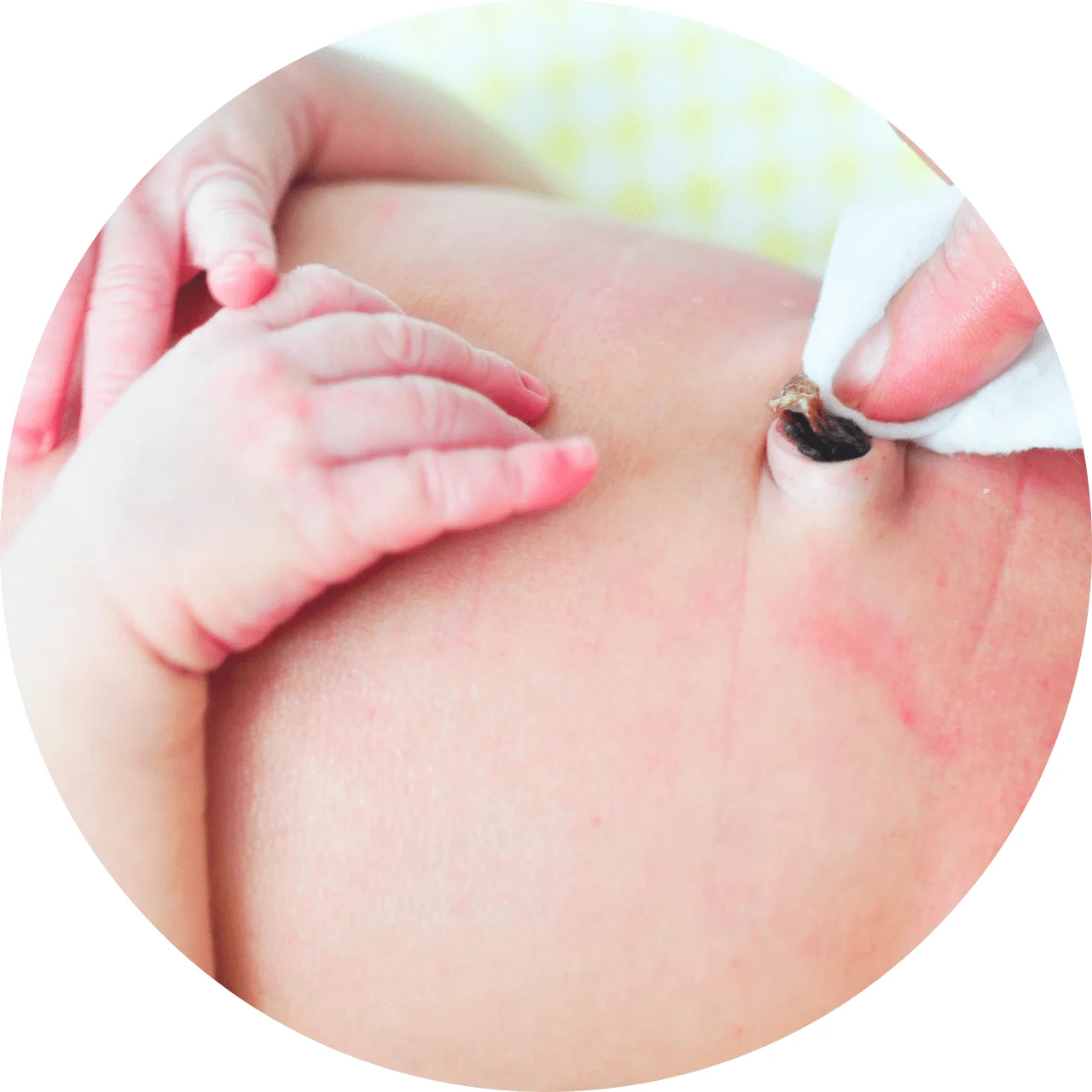አራስ እና የ1 ሳምንት ልጅ
አራስ እና የ1 ሳምንት ልጅ
እንዴት እንደዚህ ያለ ትንሽ ነገር ትልቅ ድምጽ ያሰማል?
ከማልቀስ በቀር፣ አዲስ የተወለደ ህጻን ምን እያደረገ እንዳለ እነሆ።
ዋና ነጥቦች
ልጅዎ በመጨረሻ እዚህ አለ! ከዘጠኝ ወራት ጥበቃ በኋላ፣ በመደነቅ እና በመጠባበቅ፣ ያ ጣፋጭ መዓዛ ያለው የቁንጅና ቅንጅት በእጆችዎ ውስጥ አለ።
ምናልባት አራስ ልጃችሁ ትንሽ አይን ያብሳል እና በትንሽ ሾጣጣ ቅርጽ ያለው ጭንቅላት ይሸበሸበሻል ብለው አልጠበቁትም ነገር ግን በእምስዎ ቋጠሮ በፈሳሽ በተሞላ ማህፀኗ ውስጥ ለረጅም ጊዜ መቆየቷን እና ከሴት ብልት መውለድ ከደረሰብዎ በወሊድ ቦይ በኩል ያለውን ጥብቅ መጭመቅ ግምት ውስጥ ማስገባት ተገቢ ነው።
አሁንም፣ ልጅዎ ቆንጆ ነው፣ እና ሳምንቶች እየጨመሩ ሲሄዱ የበለጠ ይሆናል፣ “አዲስ የተወለደ መልክ” ከመጀመሪያዎቹ ወራት በኋላ እየደበዘዘ ይሄዳል።
እነዚያን የመጀመሪያዎቹን ኩላሊቶች፣ ምግቦች እና ከቆዳ ወደ-ቆዳ ሹካዎች ማጣፈሱን ያስታውሱ። ከአዲሱ የቤተሰብዎ አባል ጋር የመተሳሰሪያ ሂደቱን ለመጀመር ጊዜው አሁን ነው።
ያስታውሱ እነዚህ የፍቅር እና የመተሳሰር ስሜቶች ሁል ጊዜ በራስ-ሰር የሚከሰቱ አይደሉም፣ ነገር ግን አንዳንድ ጊዜ በሚቀጥሉት ሳምንታት እና ወራት ውስጥ ለማደግ ጊዜ ይወስዳሉ።
አዲስ በተወለደ ልጅዎ የመጀመሪያ ሳምንት ውስጥ ምን መጠበቅ ይችላሉ? እዚህ ጨረፍታ ነው።
አዲስ የተወለደ እና የ1 ሳምንት ህፃን እድገት
ሳምንት 0-1
የሕፃን እድገት

ልጅዎ በዚህ ሳምንት ምን ማድረግ ይችላል? ሆዷ ላይ ስትቀመጥ ጭንቅላቷን ለአጭር ጊዜ ማንሳት ትችላለች። እሷም ከ 8 እስከ 12 ኢንች ርቀት ላይ ባሉ ነገሮች ላይ ማተኮር ትችላለች - ልክ እሷን በምታይበት ጊዜ ፊትዎ ምን ያህል ርቀት ይኖረዋል። እና በዚህ ሳምንት ብዙ ልታደርጉት የምትችሉት ነገር ነው… እና በመጪዎቹ ሳምንታት!
ነገር ግን ምናልባት ከአራስ ህጻን ባህሪያቶች ውስጥ በጣም የሚስተዋሉት ውስጠ-ግንቡ ምላሽ ሰጪዎች በሁሉም አዲስ ሕፃናት ላይ መደበኛ ችግር ይሆናሉ፣ ሁሉንም አስፈላጊ የሆነውን ስርወ ምላሽ (ጉንጯን ሲመታ ወደዚያ አቅጣጫ ትዞራለች፣ ይህም ህፃኑ ጡትን ወይም ጠርሙሱን እንዲያገኝ ይረዳታል)፣ ስታርትል ወይም ሞሮ ሪፍሌክስ እና ጡት የሚጠባ ጡትን ወይም ጡጦን በሚፈጥርበት መንገድ)።
ልጅዎ መጀመሪያ ላይ በጣም የሚያንቀላፋ ቢመስለው አትደነቁ።በህይወት በሁለተኛው እና በሦስተኛው ቀን ውስጥ ረዘም ያለ የእንቅልፍ ጊዜ መጨመር ይጠበቃል - እና ምናልባትም አዲስ ለተወለዱ ሕፃናት አድካሚ ከሆነው የመወለድ ሥራ እንዲያገግሙ እድል ለመስጠት የተነደፈ ነው። እና አንተ ብቻ የደከመህ መስሎህ ነበር!
ሳምንታት እየከፈቱ ሲሄዱ ረዘም ያለ የንቃት ጊዜ ይኖራታል። ለአሁን በእንቅልፍነቷ ተጠቀም እና ስታርፍ ለማረፍ ሞክር።
በጨረፍታ

የእንቅልፍ መሰረታዊ ነገሮች
አዲስ የተወለዱ ሕፃናት እስከ 3 ወይም 4 ወር ድረስ በ 24 ሰዓት ጊዜ ውስጥ ከ14 እስከ 17 ሰአታት መተኛት ያስፈልጋቸዋል፣ አብዛኛውን ጊዜ በየሁለት እስከ አራት ሰዓቱ ለመብላት ይነቃሉ።

የመመገብ መሰረታዊ ነገሮች
ጡት ያጠቡ ሕፃናት በዚህ እድሜ የፈለጉትን ያህል መብላት አለባቸው፣ ነገር ግን አጠቃላይ የአውራ ጣት ህግ ከ16 እስከ 24 አውንስ የጡት ወተት ወይም በ24 ሰአታት ውስጥ ድብልቅ ነው።

ይህን ያውቁ ኖሯል?
ህጻኑ ከተወለደ በኋላ ክብደት ይቀንሳል. ሁሉም ማለት ይቻላል አዲስ የተወለዱ ሕፃናት መጀመሪያ ከገቡበት ጊዜ ያነሰ ክብደት ኖሯቸው ከሆስፒታል ወይም ከወሊድ ማእከል ይወጣሉ።
አዲስ የተወለደ እና የ1-ሳምንት ልጅዎ እድገት

አዲስ የተወለደው አማካይ 7½ ፓውንድ ይመዝናል እና ወደ 20 ኢንች ርዝመት አለው። ልጅዎ ከዚያ የበለጠ ነው ወይስ ያነሰ?
አብዛኛዎቹ ሙሉ ጊዜ የሚወለዱ ሕፃናት ከ5½ እስከ 9½ ፓውንድ ይመዝናሉ በ18 እና 22 ኢንች ርዝመት መካከል ያለው ሰዓት።
እርስዎ ያልጠበቁት ነገር ይኸውና፡ ትንሽ ልጅዎ ከተወለደ በኋላ ባሉት ጥቂት ቀናት ውስጥ የተወሰነ ክብደት ይቀንሳል። እንደውም ሁሉም ማለት ይቻላል አዲስ የተወለዱ ሕፃናት ገና ሲወለዱ ከሆስፒታል የሚወጡት ክብደታቸው ያነሰ ሲሆን በመጀመሪያው ሳምንት በአማካይ ከ5 እስከ 10 በመቶ የሚሆነውን የልደት ክብደታቸው ይቀንሳል።
ትንሹ ልጃችሁ ያንን ክብደት መቼ እንደሚመልስ እያሰቡ ነው? ጡት ያጠቡ ጨቅላ ሕፃናት - በተለምዶ በመጀመሪያዎቹ የመመገብ ቀናት ውስጥ የሻይ ማንኪያ ኮሎስትረም ብቻ የሚወስዱ - እስከ ሁለተኛ ሳምንቱ ድረስ ወደ ልደት ክብደታቸው አይመለሱም። ፎርሙላ የተመገቡ ሕፃናት ክብደታቸው ከዚያ ቀደም ብሎ ወደ ኋላ ተመልሶ ሲያሽከረክር ሊመለከቱ ይችላሉ።
አዲስ የተወለደው እና የ1 ሳምንት ህፃን ጤና

Baby Apgar ፈተናዎች እና ውጤቶች
ዶክተሮች የሕፃኑን አጠቃላይ ሁኔታ የሚወስኑት የአፕጋር ውጤትን ከተጠቀሙ በኋላ ነው, ይህም የሕፃኑን ገጽታ, የልብ ምት, ምላሽ, የጡንቻ ቃና እና አተነፋፈስ ይገመግማል.

የቫይታሚን ኬ መርፌ
በሆስፒታል ወይም በወሊድ ማእከል ውስጥ ሰራተኞቹ የትንሽ ልጅዎን ደም የመርጋት ችሎታን ለማሻሻል የቫይታሚን ኬ ክትት ይሰጣሉ።

አዲስ የተወለዱ የማጣሪያ ሙከራዎች
አዲስ ለተወለደ ሕፃን ቧንቧ ላይ የሚደረጉ ሌሎች ምርመራዎች የሜታቦሊክ እና የሆርሞን መዛባት፣ የልብ በሽታ ምርመራ እና የመስማት ችሎታ ምርመራን ያካትታሉ።

እምብርት እንክብካቤ
የትንሽ ልጅዎን እምብርት ለመንከባከብ, ማድረግ ያለብዎት ነገር ቢኖር እከክ ንጹህ እና ደረቅ እንዲሆን ማድረግ ነው.

የ1-ሳምንት ደህና-ህፃን ጉብኝት
የሕፃኑ የመጀመሪያ የሕፃናት ሐኪም ከሆስፒታል ውጭ የሚደረግ ቀጠሮ ብዙውን ጊዜ ከተወለደ በኋላ በአንድ ሳምንት ጊዜ ውስጥ ይዘጋጃል ፣ እዚያም የተሟላ ምርመራ ታገኛለች።
ድህረ ወሊድ እና አዲስ የህፃን ምክሮች
በሚቀጥለው ባሲኔት ውስጥ ልጅዎን ከአራስ ልጅ የበለጠ ወይም ያነሰ እንዲመዝን የሚያደርገው ምንድን ነው?
ከእርግዝና በፊትም ሆነ በእርግዝና ወቅት የእራስዎን አመጋገብ እና ክብደት ጨምሮ በርካታ ምክንያቶች ወደ ጨዋታ ይመጣሉ።
ሌሎች ሚና ሊጫወቱ የሚችሉ ነገሮች የቅድመ ወሊድ ጤናዎ፣ የእራስዎ የልደት ክብደት፣ ዘረመል፣ ልጅዎ ወንድ ወይም ሴት ልጅ እንደሆነ (ወንዶች የሚመዝኑበት ሁኔታ ቢለያይም)፣ ይህ የበኩር ልጅዎ ይሁን (ከቀጣይ ልጆች ያነሱ ይሆናሉ)፣ ልጅዎ መንታ ወይም ሶስት እጥፍ (ብዙዎች ክብደታቸው ብዙውን ጊዜ ነጭ ወይም አሜሪካዊ ከሆኑ ጨቅላዎች) እና የልጅዎ ዝርያ ከአሜሪካዊ ጨቅላዎች የበለጠ ሊሆን ይችላል ሕፃናት).
ልክ 7 ፓውንድ ህጻን ገፍተሃል፣ መስጠት ወይም ውሰድ - እና ነገሮች በዚያ ክልል ውስጥ ለጥቂት ጊዜ ለስላሳ ይሆናሉ። ስለዚህ የመጀመሪያውን የድህረ ወሊድ ጉድፍ መግፋት እንዳለብህ መጨነቅህ ተፈጥሯዊ ነው።
እና ከወሊድ በኋላ የመጀመሪያዎ ሰገራ በመምጣቱ ትንሽ ቀርፋፋ ከሆነ አትገረሙ። አንደኛ ነገር፣ እንድትሄድ የሚረዳህ የሆድ ጡንቻዎችህ ተዘርግተው ተዳክመዋል። ለሌላው፣ አንጀትህ ራሱ ወደ ሥራው ወዲያው ለመመለስ ፈቃደኛ ላይሆን ይችላል - በተለይ እነዚህ ጡንቻዎች በወሊድ ጊዜ የተጎዱ ከሆነ (እረፍት ስጠኝ፣ አይደል?)።
ከዚ ውጪ፣ ግን ልክ እንደ ሀይለኛው፣ የፍርሃት መንስኤ ነው። ምናልባት ስፌትህን ስለመከፋፈል (አትጨነቅ፣ አትጨነቅ)፣ ሄሞሮይድህን ስለማባባስ፣ ከፍተኛ ህመም (እንደገና፣ በቅርቡ?!!) ወይም እፍረት መሆንህን ትጨነቅ ይሆናል፣ በተለይ አሁንም በሆስፒታል ውስጥ ክፍል የምትጋራ ከሆነ።
ነገር ግን በቶሎ አንጀትዎን እንደገና ሲያንቀሳቅሱ, በዙሪያው የተሻለ ይሆናል.
እንደ ሁልጊዜው፣ ፋይበር እና ፈሳሾች ጓደኛዎችዎ ናቸው (ምንም እንኳን ከመጠን በላይ አይውሰዱ) እና ትንሽ መራመድም ሊረዳ ይችላል (በመጀመሪያ ቀላል ያደርገዋል)። አስፈላጊ ከሆነ፣ ሰገራ ማለስለሻ እና መለስተኛ ላክስቲቭ ያንን የመጀመሪያ እንቅስቃሴ ትንሽ ምቾት እንዲቀንስ ለማድረግ ሊተባበሩ ይችላሉ፣ ነገር ግን በመጀመሪያ ሐኪምዎን ይጠይቁ።
የልጅዎን አካል ሊሸፍን የሚችል ጥሩ እና ዝቅተኛ ፀጉር ላኑጎ ይባላል እና በሚቀጥሉት ጥቂት ሳምንታት ውስጥ ይወድቃል። ለመሄድ የታሰበ፣ ምናልባት ልጅዎ በስፖርት የሚጫወትበት የቅንጦት ሜንጫ ሊሆን ይችላል።
ያ የመጀመሪያው የፀጉር ጭንቅላት - ልጅዎ ምንም አይነት ፀጉር ካለው - በሸካራነት እና በቀለም ሙሉ ለሙሉ በሚለያዩ መቆለፊያዎች ሊተካ ይችላል።
እና ያ ያበጠው ቁርጠት በልጅዎ ላይ ወይንስ በትናንሽ ሴት ልጅዎ ላይ ያበጠ ላቢያ? ፍጹም መደበኛ (እነሱ ገና በተወለደ ሕፃን ሰውነት ውስጥ በሚዘዋወሩ የእርስዎ ሆርሞኖች ምክንያት ነው)። እንዲሁም ጊዜያዊ ናቸው፣ እና እርስዎ ሳያውቁት ወደ ሕፃን መጠን ይወርዳሉ።
ያንን ቆንጆ ትንሽ ልጅ ለማውጣት ረጅም እና ብዙ ከገፋፋህ፣ ቀለበት ውስጥ ጥቂት ዙር እንደሄድክ ሊሰማህ ይችላል - እና አንተም እንደዛ ልትመስል ትችላለህ።
ጥቁር፣ ሰማያዊ እና በደም የተለኮሱ አይኖች ለአዲስ እናቶች የተለመዱ ናቸው፣ ነገር ግን ይህ ከወሊድ በኋላ ያለው ምልክት ምንም ጉዳት የሌለው እና ጊዜያዊ ነው፣ ይህም በሚገፋበት ጊዜ የፊትዎ ጡንቻዎችን የመወጠር ውጤት ነው።
መልካም ዜናው ቁስሉ እና መቅላት ይጠፋሉ እና ዓይኖችዎ በሳምንታት ወይም በቀናት ውስጥ ወደ ጤናማ ሁኔታ ይመለሳሉ.
ትንሽ ሊረዝም የሚችለው ነገር ካለህ በአይን አካባቢ ማበጥ ነው። ድካም (በቅርቡ የአባት ስም ይሆናል) እና ተጨማሪ የሰውነት ፈሳሾች (አሁንም ከእርግዝና የተረፈ) ለድህረ ወሊድ ምልክት ምስጋና ይገባቸዋል።
ስለዚህ ምን ማድረግ? በቀን ውስጥ ጥቂት ጊዜ ቀዝቃዛ መጭመቂያ ወደ ዓይንዎ መቀባት ሊረዳዎ ይችላል። የቀዝቃዛ ሻይ ከረጢቶችም በጥሩ ሁኔታ ይሰራሉ - ሻይ እብጠትን ለመቀነስ የሚረዳው ታኒን የተባለ ተፈጥሯዊ አሲሪን ይዟል። እንዲሁም እንደ አርኒካ ፣ ካምሞሚ እና ዱባ ያሉ ጎጂ ንጥረ ነገሮችን የያዘውን በማቀዝቀዣው ውስጥ ማቀዝቀዝ የሚችሉትን የዓይን ጄል መሞከር ይችላሉ ፣ ወይም በመጀመሪያ ደረጃ ጭንቅላትን ለማሳደግ በሁለት ትራስ ላይ በመተኛት እና ጨዋማ ምግቦችን እና አልኮልን በመተው የከረጢት አይንን ለመከላከል ይሞክሩ ። እና በእርግጥ ፣ እረፍት ፣ እረፍት ፣ በሚችሉበት ጊዜ ሁሉ እረፍት ያድርጉ ፣ ምንም እንኳን ይህ ፈታኝ እንደሆነ ብናውቅም ። መልካም ዜና? ይህ ደግሞ ያልፋል!
የሕፃኑን ቆዳ ወደ ቢጫነት የሚቀይር የተለመደ ሁኔታ; jaundice በሁሉም ሕፃናት ውስጥ በ60 በመቶው ይከሰታል፣ በተለይም ከተወለዱ ከሁለት እስከ ሶስት ቀናት ባለው ጊዜ ውስጥ ይታያል እና ከሳምንት እስከ 10 ቀናት የሚቆይ (እና አንዳንዴም በቅድመ-ህፃናት እና ጡት በማጥባት)።
በአብዛኛዎቹ ሁኔታዎች የጃንዲስ በሽታ በራሱ ወይም በትንሽ ህክምና ይጠፋል.
ምንም እንኳን አገርጥቶትን ለመከላከል ማድረግ የሚችሉት ነገር ባይኖርም በተለይ ልጅዎን ከሆስፒታል ወደ ቤትዎ እስኪያመጡ ድረስ በሽታው ሊፈጠር ስለማይችል የበሽታ ምልክቶችን መመልከት በጣም አስፈላጊ ነው. በዚህ መንገድ, ማንኛውም ህክምና አስፈላጊ እንደሆነ ለማየት ስለ ህጻናት ሐኪም ማማከር ይችላሉ.
የጃንዲስ በሽታ ብዙውን ጊዜ ፊቱ ላይ ይታያል, ከዚያም ወደ የሕፃኑ አካል, የዓይንን ነጭዎችን ጨምሮ.
ቀለል ያለ ቆዳ ያለው ህጻን ለጃንዲስ ለመፈተሽ ጥሩው መንገድ ትንሹን ልጅዎን በተፈጥሮ የፀሐይ ብርሃን ውስጥ ማስገባት እና የሕፃኑን ግንባር እና አፍንጫ በጣቶችዎ በቀስታ ይጫኑ። ጥቁር ቆዳ ባላቸው ሕፃናት ላይ ቢጫው በእጆቹ እና በእግሮቹ መዳፍ ላይ ብቻ ሊታይ ይችላል, ስለዚህ እዚያ ተመሳሳይ ሙከራ ያድርጉ.
እርስዎ እንዲገነዘቡት በሚያደርጉበት ቦታ ቆዳው ቢጫው ከታየ ወደ የሕፃናት ሐኪም ይደውሉ.
ሐኪሙ ምናልባት ልጅዎን ለመመርመር እና ሰውነት ያረጁ ቀይ የደም ሴሎችን በሚሰብርበት ጊዜ በደም ውስጥ የሚፈጠረውን የቢሊሩቢን መጠን ለማወቅ የደም ናሙና መውሰድ ይፈልግ ይሆናል።
ወላጆች አልተወለዱም - በስራው ላይ ተሠርተዋል-አንድ ቆሻሻ ዳይፐር, አንድ የማራቶን አመጋገብ ክፍለ ጊዜ, አንድ ገላ መታጠቢያ, አንድ መውጣት (አንድ ጊዜ መውጣትን ጨምሮ መጥረጊያዎችን ማሸግ ሲረሱ እና በድንገት ሲፈልጉዋቸው), አንድ እንቅልፍ ማጣት በአንድ ጊዜ.
እንደ እድል ሆኖ, እርስዎ ሲማሩ ህጻናት ይቅር ባይ ናቸው. እና ከሁሉም በላይ ሊረዳ የሚችለው - ከጊዜ ማለፍ እና የልምድ ክምችት በተጨማሪ - ጥሩ ጓደኛ መሆንዎን ማወቅ ነው።
እያንዳንዷ እናት፣ በምቀኝነት የምትመለከቷቸው እነዚያ ልምድ ያላቸው ባለሙያዎችም እንኳ፣ በነዚያ የመጀመሪያዎቹ ሳምንቶች ውስጥ ከመጠን በላይ የመጨናነቅ ስሜት ይሰማቸዋል፣ በተለይ ከወሊድ ማገገሚያ ጋር የተጣመረ የድህረ ወሊድ ድካም ጉዳታቸውን እየጎዳ ነው።
ስለዚህ እራስዎን ብዙ ድካም ይቁረጡ (እና እራስዎን አንድ አይብ እና አንድ ቁራጭ ዳቦ ይቁረጡ - በደም ውስጥ ያለው የስኳር መጠን መቀነስ ለዚያ ስሜት መጨናነቅ አስተዋጽኦ ያደርጋል). ለራስህ በቂ ጊዜ ስጥ እና ከወላጅነት ፕሮግራም ጋር ተገናኝ።
በቅርቡ፣ የሕፃን እንክብካቤ የዕለት ተዕለት ተግዳሮቶች ከእንግዲህ ፈታኝ አይሆኑም። እንደ እውነቱ ከሆነ, እነሱ በተፈጥሯቸው ይመጣሉ, በእንቅልፍዎ ውስጥ ሊያደርጉዋቸው ይችላሉ (እና ብዙውን ጊዜ እርስዎ እንደሆኑ ይሰማዎታል). ከነሱ ምርጦች ጋር ዳይፐር ትለብሳለህ፣ ትመገባለህ፣ ታቃጥላለህ እና ታረጋጋለህ። ወላጅ ይሆናሉ - እና ወላጆች፣ እርስዎ ያልሰሙ ከሆነ፣ ምንም ነገር ማድረግ ይችላሉ።
ከወሊድ በኋላ ከሁለት እስከ አምስት ቀናት አካባቢ፣ ወተትዎ ወደ ውስጥ ከገባ በኋላ፣ ጡትዎ ወደ ውስጥ ከገባ በኋላ፣ ጡቶችዎ ይሞቃሉ እና በሚያስደንቅ ሁኔታ - እንደ ድንጋይ ጠንካራ ይሆናሉ፣ ይልቁንም ሁለት ቋጥኞች። ሁለት በጣም የሚያሰቃዩ ድንጋዮች።
ጡት የማታጠቡ ከሆነ, ቁስሉ በጥቂት ቀናት ውስጥ መቀነስ አለበት. በዚህ ሁኔታ, መጨናነቅን ለመቀነስ የተንቆጠቆጠ ብሬን መልበስ ያስፈልግዎታል.
እንዲሁም ማንኛውንም አይነት የጡት ጫፍ ማነቃቂያ ወይም የወተት አገላለፅን ማስወገድ ይፈልጋሉ - አለበለዚያ ጡቶችዎ ወተት ማፍራታቸውን ይቀጥላሉ. የበረዶ መጠቅለያዎች ምቾትን ለመቋቋም ይረዳሉ.
ጡት እያጠቡ ከሆነ, ከሁለት እስከ ሶስት ቀናት ባለው ጊዜ ውስጥ መጨናነቅ ይቀንሳል ብለው መጠበቅ ይችላሉ. ነገር ግን ልጅዎ እና ጡትዎ ጥሩ የአቅርቦት እና የፍላጎት ግንኙነት ለመፍጠር ጥቂት ሳምንታት ሊወስድ ይችላል።
እስከዚያው ጊዜ ድረስ የመተንፈስን ህመም እና ምቾት ለመቀነስ ሊወስዷቸው የሚችሏቸው አንዳንድ እርምጃዎች አሉ ይህም በየሁለት እና ሶስት ሰዓቱ ልጅዎን መመገብ, ከምግብ ክፍለ ጊዜ በፊት ሞቅ ያለ መጭመቂያዎችን መጠቀም እና ቀዝቃዛ መጭመቂያዎችን መጠቀም, በፓምፕ ወይም በእጅ ትንሽ ወተት መግጠም እና ጡቶችዎን ማሸት.
መግዛት ያለባቹ ነገሮች
-
 የተገላቢጦሽ ክፍያ ክፍያ">
የተገላቢጦሽ ክፍያ ክፍያ">
-
 ኦኔሲዎች">
ኦኔሲዎች">
-
 ስዋድል">
ስዋድል">
-
 Baby bottle">
Baby bottle">
-
 Stroller">
Stroller">
-
 Voyage Yoga Bag">
Voyage Yoga Bag">
-
 Impulse Duffle">
Impulse Duffle">
-
 Fusion Backpack">
Fusion Backpack">
-
 ተቀናቃኝ የመስክ መልእክተኛ">
ተቀናቃኝ የመስክ መልእክተኛ">
-

ኦኔሲዎች
Br50.00ወደ የምኞት ዝርዝር ያክሉወደ ጋሪው አክል፡ "%s"ወደ የምኞት ዝርዝር ያክሉ -

Stroller
Br32.00ወደ የምኞት ዝርዝር ያክሉወደ ጋሪው አክል፡ "%s"ወደ የምኞት ዝርዝር ያክሉ -
Sale!

Baby bottle
Br25.00 – Br30.00ወደ የምኞት ዝርዝር ያክሉSelect options This product has multiple variants. The options may be chosen on the product pageወደ የምኞት ዝርዝር ያክሉ








አስተያየት ጨምር